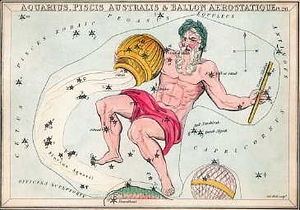Aquarius (constellation)
| Constellation | |
 List of stars in Aquarius |
|
| Abbreviation | Aqr |
|---|---|
| Genitive | Aquarii |
| Pronunciation | /əˈkwɛəriəs/, genitive /əˈkwɛəriaɪ/ |
| Symbolism | the Water-bearer |
| Right ascension | 23 h |
| Declination | −15° |
| Quadrant | SQ4 |
| Area | 980 sq. deg. (10th) |
| Main stars | 10, 22 |
| Bayer/Flamsteed stars |
97 |
| Stars with planets | 7 |
| Stars brighter than 3.00m | 2 |
| Stars within 10.00 pc (32.62 ly) | 7 |
| Brightest star | β Aqr (Sadalsuud) (2.90m) |
| Nearest star | EZ Aqr (11.27 ly, 3.45 pc) |
| Messier objects | 3 |
| Meteor showers | March Aquariids Eta Aquariids Delta Aquariids Iota Aquariids |
| Bordering constellations |
Pisces Pegasus Equuleus Delphinus Aquila Capricornus Piscis Austrinus Sculptor Cetus |
| Visible at latitudes between +65° and −90°. Best visible at 21:00 (9 p.m.) during the month of October. |
|
Aquarius is a constellation of the zodiac, situated between Capricornus and Pisces. Its name is Latin for "water-bearer" or "cup-bearer", and its symbol is ![]() (Unicode ♒), a representation of water.
(Unicode ♒), a representation of water.
Aquarius is one of the oldest of the recognized constellations along the zodiac (the sun's apparent path). It is found in a region often called the Sea due to its profusion of constellations with watery associations such as Cetus the whale, Pisces the fish and Eridanus the river.
Contents |
Notable features

- See also: List of stars in Aquarius
Planetary systems
- Gliese 876 is the first planetary system found around a red dwarf star. The planetary system has three planets, including one terrestrial planet 6-8 times the mass of Earth.
- 91 Aquarii b is a planet found around the orange giant star. Its mass is 2.9 times Jupiter and the semimajor axis of its orbit is 0.3 AU.
- Gliese 849 b is the first long-period Jupiter-like planet found around the red dwarf star. Its mass is 0.82 times Jupiter and the semimajor axis of its orbit is 2.35 AU.
Deep sky objects
There are three deep sky objects that are on the Messier catalog: the globular clusters Messier 2, Messier 72, and the open cluster Messier 73. Two well-known planetary nebulae are located in Aquarius: the Saturn Nebula (NGC 7009), to the southwest of η Aquarii; and the famous Helix Nebula (NGC 7293), southwest of δ Aquarii.
Illustrations

In illustrations, the brightest stars of Aquarius are represented as the figure of a man, while the fainter naked eye stars are represented as a vessel from which is pouring a stream of water. The water flows southwards into the mouth of the southern fish, Piscis Austrinus.
Mythology
Aquarius is identified as GU.LA "The Great One" in the Babylonian star catalogues and represents the god Ea himself.[1] It contained the winter solstice in the Early Bronze Age.[2] In Old Babylonian astronomy, Ea was the ruler of the southernmost quarter of the Sun's path, the "Way of Ea", corresponding to the period of 45 days on either side of winter solstice. In the Greek tradition, the constellation became represented as simply a single vase from which a stream poured down to Piscis Austrinus. The name in the Hindu zodiac is likewise kumbha "water-pitcher", showing that the zodiac reached India via Greek intermediaries.[3]
Aquarius is sometimes identified with Ganymede, a beautiful youth in Greek mythology with whom Zeus fell in love and, in the disguise of an eagle (represented by the constellation Aquila) carried off to Olympus to be cup-bearer to the gods.
Aquarius has also been identified as the pourer of the waters that flooded the Earth in the ancient Greek version of the Great Flood myth. As such, the constellation Eridanus the river is sometimes identified as a river being poured by Aquarius.
Aquarius may also, together with the constellation Pegasus, be part of the origin of the myth of the Mares of Diomedes, which forms one of The Twelve Labours of Heracles. Its association with pouring out rivers, and the nearby constellation of Capricornus, may be the source of the myth of the Augean stable, which forms another of the labours.
Astrology
As of 2002[update], the Sun appears in the constellation Aquarius from February 16 to March 11. In tropical astrology, the Sun is considered to be in the sign Aquarius from January 20 to February 19, and in sidereal astrology, from February 15 to March 14.
References
- ↑ Gavin White, Babylonian Star Lore (unknown publisher, 2007), p. 123.
- ↑ http://books.google.com/books?id=rNpHjqxQQ9oC
- ↑ John H. Rogers, "Origins of the ancient contellations: I. The Mesopotamian traditions", Journal of the British Astronomical Association 108 (1998) 9–28
- Ian Ridpath and Wil Tirion (2007). Stars and Planets Guide, Collins, London. ISBN 978-0007251209. Princeton University Press, Princeton. ISBN 978-0691135564.
- H. A. Rey, The Stars—A New Way To See Them. Enlarged World-Wide Edition. Houghton Mifflin, Boston, 1997. ISBN 0-395-24830-2.
 This article incorporates text from a publication now in the public domain: Chisholm, Hugh, ed (1911). Encyclopædia Britannica (Eleventh ed.). Cambridge University Press.
This article incorporates text from a publication now in the public domain: Chisholm, Hugh, ed (1911). Encyclopædia Britannica (Eleventh ed.). Cambridge University Press.
External links
- The Deep Photographic Guide to the Constellations: Aquarius
- NightSkyInfo.com: Constellation Aquarius
- WIKISKY.ORG: Aquarius constellation
- Star Tales – Aquarius
|
||||||||
|
|||||
|
||||||||||||||||||||||||||||||||
| Astronomy | Constellations of the Zodiac |
|---|
| Pisces ★ Aries ★ Taurus ★ Gemini ★ Cancer ★ Leo ★ Virgo ★ Libra ★ Scorpius ★ Ophiuchus ★ Sagittarius ★ Capricornus ★ Aquarius |